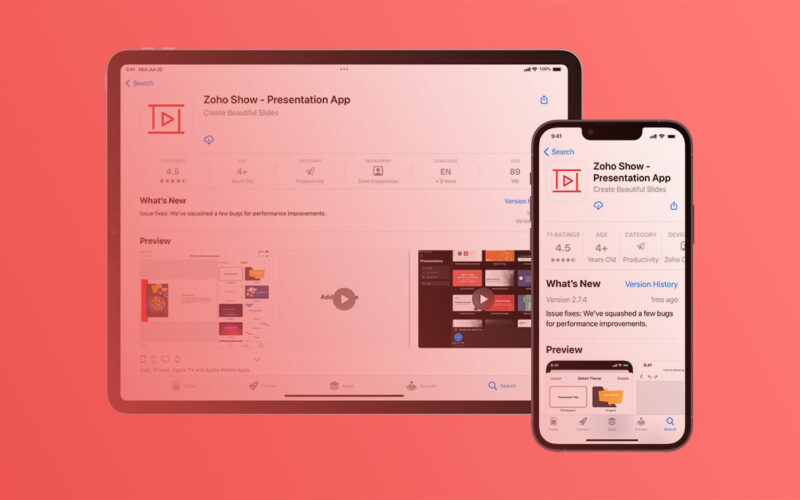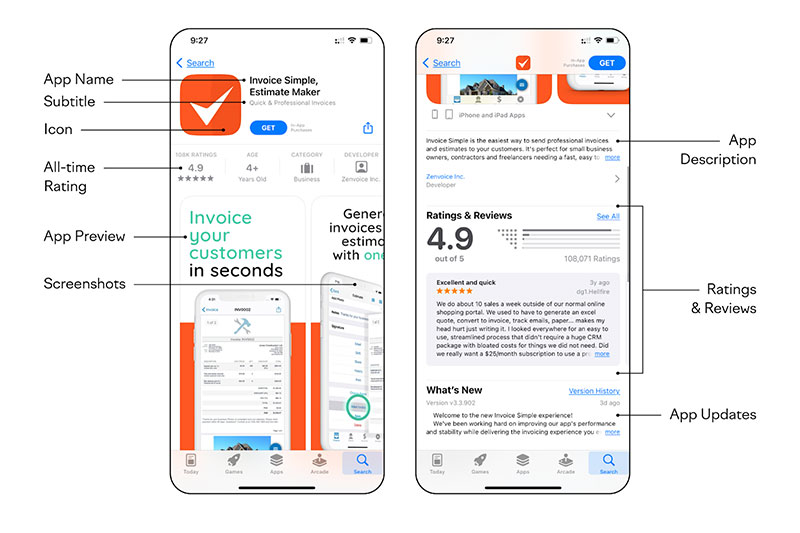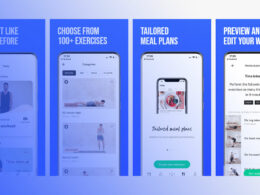App Store Keywords: Best Practices for Visibility

Picture this: your brilliant app, the result of sleepless nights and countless cups of coffee – it’s ready. But, getting it into the palms of users is the real game-changer, and let’s face it, that coveted spotlight in the App Store hinges on something often overlooked – app store keywords best practices.
In the digital marketplace’s bustling aisles, your app’s discoverability is king. Harnessing the power of App Store Optimization (ASO) can catapult your creation from the shadows of obscurity to the top of the search results.
Here, you’ll unearth the intricate dance of keyword optimization that aligns with the ever-evolving app store algorithms.
By the close of this deep-dive, you’ll wield the tools to boost your app’s visibility, refine your metadata, and tap into the psyche of the search behavior in app stores.
From app ranking factors to localization strategies, this isn’t just a how-to guide; it’s your ticket to mastering the organic app user acquisition arena.
Prepare for insights that slice through the noise, strategies that skyrocket downloads, and real-talk on optimizing every swipe and tap. This is your playbook, your edge in the virtual shelf space. Let’s make your app unmissable.
App Store Keywords Best Practices
| Best Practice | Details |
|---|---|
| Use Relevant Keywords | Focus on keywords that are closely related to the app’s features, functionality, and target audience. |
| Research Competitors | Analyze competitors’ keyword strategies to identify gaps and opportunities. |
| Utilize All Available Characters | The App Store allows up to 100 characters for keywords. Use this space efficiently by including as many relevant keywords as possible. |
| Avoid Repetition | Repeating keywords in the title, subtitle, and keyword field is unnecessary. Apple’s algorithm considers all these fields for indexing. |
| Use Singular or Plural, Not Both | Opt for either singular or plural forms of words, not both, unless they rank differently. |
| Avoid Using Conjunctions & Prepositions | Skip conjunctions (and, or) and prepositions (for, with) to save space for more impactful keywords. |
| Update Keywords Regularly | Periodically review and update keywords based on performance analytics, market trends, and competitor changes. |
| Localize for All Targeted Regions | Provide localized keywords for each targeted region to cater to the local audience. |
| Avoid Banned Keywords | Stay clear of using trademarked terms, inappropriate language, or other banned keywords that could lead to rejection or penalization by the App Store. |
| Use Tools for Keyword Research | Leverage App Store Optimization (ASO) tools and services for keyword research and tracking to refine your keyword strategy. |
Keyword Research Strategies

Understanding User Search Behavior
Diving into the minds of your audience isn’t a piece of cake, but hey, that’s where the magic happens. When you zoom in on user search behavior, you’re basically playing detective.
You’ll want to decode the ‘why’ behind each tap and swipe. It’s all about peeling back the layers of analysis of search queries and the intentions users carry like invisible backpacks.
You could say that app store keywords best practices are your compass here.
Figuring out what words folks punch into that search bar, you get to see patterns. Are they hunting for “fast calorie counters” or maybe “easy budget trackers”?
Utilizing search trend tools that spill the beans on what’s hot and what’s not is crucial. Data here is golden.
Notice a spike in “meditation apps” around New Year’s? That’s not just holiday stress talking; it’s a trend you can ride.
Tools and Techniques for Effective Keyword Research
Let’s talk gadgets and gear—your ASO tools. These bad boys range from keyword planners to analytics dashboards that could rival a spaceship’s controls.
They’re the bread and butter of sorting out what keywords hold the key to your app’s visibility.
Ever tried out one of these tools? They can give you a list of keywords that are like catnip for users.
Sometimes they’re about as obvious as a fireworks show, other times as subtle as a secret handshake. Understanding which ones can make your app the talk of the town is a fine art.
Now for the fun part. Taking these keywords for a spin with these tools opens up a world of undiscovered potential.
High-potential keywords are the treasure at the end of the rainbow, and with the right tool, you’re bound to find them.
Analyzing Competitors’ Keyword Strategies

Oh, the competition. They’re out there making moves, but here’s the kicker—you can learn from them.
Keeping tabs on competitors’ top-performing keywords can give you a yellow-brick road to follow. What’s snagging them that top app store real estate?
Learning from both their wins and their faceplants means you’re in the loop. It’s like getting a sneak peek at their playbook.
So, press your nose against that figurative glass and watch closely. Which keywords are they banking on? Which ones are they missing that you could snag up?
Crafting Your Keyword Portfolio
Selecting Primary vs. Secondary Keywords
It’s like building a fantasy football team, except here, each player is a keyword and they’re all gunning for the MVP – Most Valuable Phrase.
The primary keywords, those are your quarterbacks. They’re the ones you expect to score most of your points – make or break your app’s visibility league.
Picking these is no random dart throw. It’s a calculated decision based on stuff like search volume, relevance, and how tough the competition is.
You wouldn’t send a peewee player into the pro league, right? Same deal with keywords; you gotta choose ones that can hold their ground.
Now, secondary keywords are your support squad. They add depth to your game plan.
Sneak them into your app’s playbook – the description, the updates – to avoid that dreaded penalty called keyword stuffing. It’s a smooth tango between offering just enough hints to catch those search algorithms’ eyes without tripping over yourself.
Localization and Cultural Considerations
Oh, and let’s talk about the home grounds. Apps go global, but searches? They’re as local as your neighborhood pizza joint.
This means morphing your keywords to speak every language, catch every local trend, and ride the cultural wave. It’s not just translation; it’s transformation.
A keyword that’s kicking up a storm in the States might be a no-show overseas.
To resonate with folks in France, Germany, Japan – wherever, you gotta tune into their frequencies. It’s part regional lingo, part diving into what makes each corner of the world tick.
Continuous Optimization and Updating
Here’s the kicker – the game never stops. Those keywords you picked? They’re not set in stone.
Audiences evolve, trends come and go, and your app’s gotta sway with that rhythm.
Monitoring keyword performance is like checking the pulse of your app’s heart.
And just when you think you’ve nailed it, it’s time to shake things up again. Keep those keywords fresh, keep ‘em rolling with the times. A constant cycle of test, tweak, and triumph.
Always be ready to swap out words that are past their prime with frisky newcomers that could climb the charts.
It’s a never-ending season in the league of app store keywords best practices, and staying on your toes is the name of the game.
Implementation of Keywords in App Store Elements
Optimizing App Title and Subtitle

Okay, picture this: you’re scanning the app store, browsing like you do when your favorite show ends its season.
You’re going to click on something that catches your eye, right? That’s what your app’s title and subtitle are up against. They need to pack a punch.
But here’s the tightrope walk – you’ve got to stay true to what your app is all about (keep it real for your brand) while also tempting those search engine bots with juicy keywords.
It’s like naming a masterpiece; it’s gotta be bold but also have those magic words that users are looking for.
The catch? You can’t go overboard. App stores have rules, character limits – boundaries that keep things tidy. Work within those.
It’s about being crafty, not spammy.
Crafting Keyword-Rich Descriptions
Now, let’s chat about storytelling. Your app’s description is where you can really go to town. It’s the pitch, the romance, the “once upon a time” that could lead to “happily downloaded after.”
This is where your app store keywords best practices come into play, big time.
You want your description to flow like a good conversation. It should be packed with keywords, yeah, but also engaging and super clear on what your app is bringing to the table.
Nobody likes a robotic list; they want the scoop – what’s in it for them? Keep it peppery with keywords, but make sure it reads naturally.
Metadata and Beyond
Alright, let’s geek out a bit. Metadata isn’t exactly water cooler talk, but it’s where a lot of the behind-the-scenes magic happens.
Your app’s got a backstage, and that’s where the metadata hangs out. This includes stuff like your URL/package name – and yeah, keywords matter here too.
But wait, there’s more. Visuals – think screenshots, promo videos – they’re not just eye candy.
These can complement your keywords, show your app’s vibe, and back up what you’re saying with some show-and-tell.
The secret is to tag these visuals with, you guessed it, keywords. It’s like adding secret ingredients to your grandma’s famous recipe that make people go “Wow!”
Measuring Keyword Success and Performance
Key Performance Indicators (KPIs) for Keywords

You launch your app. You’ve played your part, decked it out with all the right words. But how do you know if those words are the charmers you need them to be?
It’s by keeping score, checking the stats. We’re talking download rates, seeing those numbers climb.
Then there’s conversion rates – not just window shoppers, but folks actually downloading your masterpiece. And don’t forget, your app’s gotta be as visible on search just like a lighthouse in the dark.
Now, don’t panic, you’ve got tools for this mission. And these tools, they’re like those fitness trackers, but for your app.
They keep tabs on your keywords, give you the lowdown on what flies and what flops. Use them, love them. They’re part of your arsenal now.
Risks and Pitfalls in Keyword Strategy
Here’s the thing. You can stumble if you try to run before you can walk. Keyword stuffing? Yeah, that’s a banana peel waiting to happen.
Too many keywords crammed in, and it’s not just the users who’ll raise eyebrows. App stores might just show you the door. Users smell the desperation – they want smooth, natural.
So, keep it cool, avoid the cram.
Advanced Keyword Strategies
Leveraging Long-Tail Keywords
Think of keywords like a treasure hunt. Sure, everyone’s after the shiny chest of popular terms, but then there’s those hidden gems, the long-tail keywords.
They might not look like much at first glance, but oh boy, they pack a punch.
Long-tail keywords are like secret passageways. You know, those long, quirky phrases folks type when they’re looking for something really specific.
Not as crowded, less folks jostling for a spot, so your odds? Way better.
Take a story I heard about this indie app. Used a long-tail like “quick gluten-free recipes.” Not just “recipes” mind you, but really honed in there.
And guess what? It hit the bullseye for folks searching for that exact thing. That’s the kind of eagle-eye targeting that could level up your game.
Integration with Overall ASO and Marketing Efforts
Now let’s zoom out a bit. Keywords, they’re part of a bigger picture. You can’t just sprinkle them in and call it a day.
They gotta groove with your App Store Optimization (ASO), your snapshots, your vibe – even those posts you drop across socials.
Imagine your keyword strategy as the drummer in your band. It’s gotta be in sync with the guitars, the vocals, the whole ensemble, to rock the house.
Make sure when you’re splashing your visuals and words all about, your keywords are the beat everyone’s moving to.
FAQ On App Store Keywords Best Practices
What are app store keywords best practices?
They’re like your app’s lifeline to the world. You need to pick words thoughtfully, understanding what people search for, no stuffing too many keywords, and keeping an eye on trends.
Think relevancy, demand, and a bit of that secret sauce—creativity.
How do I choose the right keywords for my app?
Get into your user’s head. What would they type to find your app? Use tools that suggest high-flying words; pick ones relevant to your app’s purpose and function.
Think specific, think niche—it’s about standing out in the crowd of apps.
Should I focus on popular or niche keywords?
It’s a balancing act. Sure, popular keywords get traffic, but they’re like a crowded party where it’s harder to be heard. Niche keywords?
Less noise, easier to find your groove. Mix it up. Toss the big fish into your keyword pool, but sprinkle in those niche words too.
How often should I update my app store keywords?
Stay on your toes—markets pulse, trends shift. Regular check-ups, maybe monthly, to see how your words are playing with the audience.
Refresh, tweak, stay fresh. It’s like doing maintenance on your car so the ride stays smooth.
Can keywords affect my app store rankings?
Absolutely. Keywords are like the current that powers the rankings boat. Get them right, and you’ll sail smoothly toward visibility.
Miss the mark, and you might find yourself drifting. It’s about relevance and search demand—find the sweet spot.
How do I implement keywords without keyword stuffing?
It’s the crafting that counts. Embed keywords like they’re part of the conversation—not forced, not awkward.
Your app description should read smoothly, with keywords flowing like they just popped into the chat. Make it natural, make it engaging.
Why is localization important in keyword selection?
Imagine walking into a room and everyone’s speaking your language—that’s what localization feels like to your users. Keywords that resonate with local flair, culture, and language hit closer to home and give you an edge in global markets.
How does ASO differ from SEO?
Cousins in the digital marketing family—but they go to different schools. ASO is about shining in app stores, using keywords tailored for app names, descriptions, and metadata.
SEO focuses on websites, crafting content to climb search engine ranks. Both care about keywords, just strutting their stuff on different stages.
What tools can help with keyword research for apps?
There’s a toolbox full of helpers out there. From App Annie to Sensor Tower, these are your guides through the keyword wilderness, offering insights on performance, competition, and trends. It’s how you discover words you might never have thought of.
How do keywords impact my app’s conversion rate?
Keywords are your store’s display windows. The right ones attract users by matching their search intent, boosting the chances they’ll engage and convert. It’s show and tell—show up in their searches, tell them you’ve got what they need.
Conclusion
Wrapping our heads around app store keywords best practices isn’t just about the here and now. It’s a nod to the future, to updates and shifts in how people find and fall in love with apps. We talked game plans, ASO tools, chance encounters with niche keywords, and that cool, behind-the-scenes world of metadata.
But let’s be real, it’s more than just tips and tricks. It’s about understanding that fine line between science and art. It’s strategic, sure—with data, analytics, and performance tracking. At the same time, it’s a creative journey; crafting sentences that weave in keywords like they’re part of a casual heart-to-heart.
So, take a deep breath. Look over what we’ve covered:
- Optimizing without overdoing.
- Localizing like a travel pro.
- Staying agile in a world that never stops spinning.
That’s the rhythm of mastering keywords in the app cosmos. Now go ahead, tweak those titles, adjust those descriptions, and watch as your app finds its way to the spotlight it deserves.
If you liked this article about app store keyword best practices, you should check out this article about Google Play A/B testing.
There are also similar articles discussing how to measure mobile app performance, in-app feedback, app store rating, and mobile app growth.
And let’s not forget about articles on improving app store conversion rate, Google Play store fees, Apple app store fees, and how to publish an app on Google Play.
- Drive and Earn: Essential Apps Like Doordash - May 8, 2024
- The Benefits of Integrating Geofencing with CRM Systems - May 8, 2024
- Create Your Game: The Best JavaScript Game Engines - May 8, 2024








